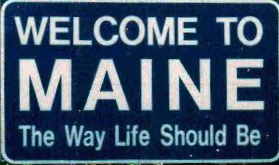“Revenge is often elaborate. That’s part of its appeal. You get to enjoy it over and over again as you plan it.
 Simon Greenleaf Howe, owner and editor of the Red Paint Register, has been living in rural Red Paint, Maine, for most of the twenty-five years since he graduated from high school there. “[A] town sign wasn’t really necessary. People didn’t just happen upon Red Paint. If you took the spur road off the interstate, you probably already lived there and knew where you were going.” With his wife Amy, a psychiatric therapist, and his eleven-year-old son Davey, who is at a rebellious age, Simon enjoys the relatively bucolic environment and his ability to run his own life and job. So little happens in Red Paint, in fact, that Simon is thinking about a new tagline for the Register: “Nothing Happens—and We Report It.” But something has happened, and something more is about to happen, not just the high school’s 25th Reunion, which is scheduled in a few weeks, but a threat to Simon’s own life related to events that occurred twenty-five years ago.
Simon Greenleaf Howe, owner and editor of the Red Paint Register, has been living in rural Red Paint, Maine, for most of the twenty-five years since he graduated from high school there. “[A] town sign wasn’t really necessary. People didn’t just happen upon Red Paint. If you took the spur road off the interstate, you probably already lived there and knew where you were going.” With his wife Amy, a psychiatric therapist, and his eleven-year-old son Davey, who is at a rebellious age, Simon enjoys the relatively bucolic environment and his ability to run his own life and job. So little happens in Red Paint, in fact, that Simon is thinking about a new tagline for the Register: “Nothing Happens—and We Report It.” But something has happened, and something more is about to happen, not just the high school’s 25th Reunion, which is scheduled in a few weeks, but a threat to Simon’s own life related to events that occurred twenty-five years ago.
 As the novel opens, Simon reveals to his wife that he has hired a new employee who previously worked for a Portland newspaper and was a former farm team player for the Red Sox. Most recently, however, the man has been unemployed – serving a six year term in the jail in Warren for an assault on a woman. Appalled at Simon’s lack of curiosity about this crime, Amy, not surprisingly takes the side of the woman victim, wondering aloud if the victim, too, has a new job, “that is, if she’s gotten over the trauma of being sexually assaulted by your new hire.” The new employee has told Simon that there are two sides for everything, but Amy feels such crimes are too damaging to women to be forgiven and she refuses to meet him. Whether or not he will be able to start a new life in Red Paint is an open question, as the author introduces his themes of crimes, atonement, and forgiveness.
As the novel opens, Simon reveals to his wife that he has hired a new employee who previously worked for a Portland newspaper and was a former farm team player for the Red Sox. Most recently, however, the man has been unemployed – serving a six year term in the jail in Warren for an assault on a woman. Appalled at Simon’s lack of curiosity about this crime, Amy, not surprisingly takes the side of the woman victim, wondering aloud if the victim, too, has a new job, “that is, if she’s gotten over the trauma of being sexually assaulted by your new hire.” The new employee has told Simon that there are two sides for everything, but Amy feels such crimes are too damaging to women to be forgiven and she refuses to meet him. Whether or not he will be able to start a new life in Red Paint is an open question, as the author introduces his themes of crimes, atonement, and forgiveness.
 Soon after, Simon receives the first of what will eventually number six postcards from around the country, none of them signed, but gradually hinting at some terrible deed that Simon committed in the past. Simon has no idea what it is. As the cards are mailed from closer and closer cities, first from the Salt Lake, and then from Chicago, Philadelphia, Boston, and Portland, Simon and Amy become more stressed and more impatient with each other. The final postcard, proclaiming “It’s Bigger in Maine,” is hand-delivered, and the message demands that Simon meet with the sender on the dock below the local Bayswater Inn during the 25th reunion celebration.
Soon after, Simon receives the first of what will eventually number six postcards from around the country, none of them signed, but gradually hinting at some terrible deed that Simon committed in the past. Simon has no idea what it is. As the cards are mailed from closer and closer cities, first from the Salt Lake, and then from Chicago, Philadelphia, Boston, and Portland, Simon and Amy become more stressed and more impatient with each other. The final postcard, proclaiming “It’s Bigger in Maine,” is hand-delivered, and the message demands that Simon meet with the sender on the dock below the local Bayswater Inn during the 25th reunion celebration.

Oceanfront dock, Boothbay, Maine
Before the last card is delivered, their writer has been in Red Paint for a couple of weeks. He has discovered where Simon lives and has paid undiscovered visits to the house. He has followed the family and approached their son privately more than once. He conducts regular stake-outs outside, unknown to the Howes. By the time Simon receives that card, author George Harrar has ratcheted the tension up to the breaking point in the style of a classic Alfred Hitchcock thriller.
The author also allows the stalker to express his own point of view in chapters which interrupt and give context to Simon’s story, and as the stalker reveals to the reader that he lived in Red Paint many years ago, he reveals an event involving Simon Howe during Simon’s graduation week. He continues to avoid Simon in person, however, wanting to prolong the suspense in an effort to torment him, and his most devious plan is to torture Simon through his wife Amy, wreaking a most elaborate revenge.

Ocean Point Inn, in E. Boothbay, Maine, similar to the setting of this novel
A few red herrings keep the full nature of Simon’s crime from the reader and from Simon himself for a significant part of the book, and as the time gets closer to Simon’s meeting with his stalker, Simon finds his family life becoming more complicated, with Davey acting out and Amy becoming more and more hysterical with worry. Eventually, the stalker states exactly what he wants – and Simon’s simple confession to the unknown crime is not going to be enough: “Confession,” the stalker says, “isn’t really a penalty. In fact, confession can be good for the soul – it absolves the confessor. What I think is that a [betrayer] should feel what it’s like to be [utterly betrayed] himself.” The stalker will continue his vengeful attack until Simon meets him to end the torment.

That eventual meeting is more full of surprises than the reader expects, extending the long-term consequences of Simon’s initial betrayal of someone he knew twenty-five years ago to even more serious consequences as a result of his meeting with the stalker. Author Harrar raises significant questions here about betrayals, their immediate and long-term consequences, and about how one can atone for wrong-doing when s/he does not recognize it as wrongdoing at the time. And what about someone whose sole goal in life is vengeance? What options are open to him for a healthy life? What about lies which improve life, instead of destroying it? Is there a place in the moral spectrum which makes those acceptable? In fact, how much truth is really necessary, and how much guilt and inner remorse are needed to atone for misdeeds? Ironies abound here in this suspenseful study of universal themes of guilt, innocence, punishment, atonement, and absolution as seen through the seemingly simple life of a hitherto respected man in Red Paint Bay.
Photos, in order: The author’s photo comes from http://janetruthyoung.blogspot.com and accompanies an interview she had with the author about one of his earlier novels.
The 25th reunion logo appears on http://www.udconnection.com/
The oceanfront dock is in Boothbay, Maine: https://www.biddefordrec.com
The Ocean Point Inn, located in E. Boothbay, Maine, may be seen here: http://www.oceanpointinn.com
“Maine, the Way Life Should Be” is found on http://academicdiscredit.wordpress.com
ARC: Other Press
